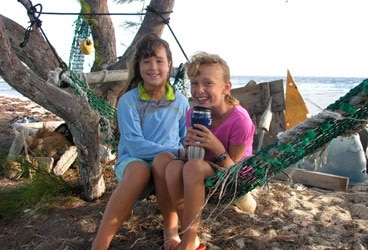
childs play 368
A lovely, cheeky little boat sailed into the anchorage a few days ago and neatly dropped the hook a quarter of a mile away. Within minutes, our kids were charging across the water in the dinghy yelling hellos, while the two children aboard the Bristol Channel Cutter hung off the shrouds waving like long-lost soul mates. They didn’t even know each other’s names. It didn’t matter. Like us, Calypso is a “kid boat,” and as soon as she pulled in, both the children and grownups zapped together like opposing magnetic poles.
We’re exceptions to the rule out here, those of us sailing with our young children. The vast majority of cruisers we’ve run across in a year and a half of sailing have been older retired couples whose chicks fledged years ago. There’s been a smattering of 20-somethings using the sailing life to find themselves or to avoid the perils of growing up, a few singlehanders (mostly men), and some middle-aged couples who either never had kids or had them young enough to be enjoying their freedom again. We’ve made friends with cruisers from each group, but there’s a special bond-driven by a singularly common experience, and often a common need-among those of us sailing with our kids.
It all sounds so perfect: You’re taking your kids cruising to show them the beauty of the world beyond suburbia, the diversity of cultures, and a different way to live. What kid wouldn’t love suffering only a few hours of school each day, then snorkeling or hiking, beachcombing, or just playing under the casuarinas? Many books, blogs, and articles imply that there are plenty of other cruising families out here, that you’ll magically find one another, that somehow your plans, budgets, and timelines will dovetail perfectly, and that everyone-children and adults alike-will mix like dark rum and ginger beer. Most important, your children will make lifelong friendships born of a unique way of life. And to some extent, this is true. This really does happen, although in my experience, it mostly happens when you stay in one place for weeks or months at a time, which many of us either can’t or won’t do.
What you don’t read so much about is that some of the kids’ common experience also includes intense homesickness, the scariness of puberty sans the counsel of their best buddies, and the challenges of cohabitating where privacy may be obtained only in a space about the size of your average bathtub. A darker side of this life may also be a deep understanding of loss at too tender an age and a fear of commitment that comes with never knowing what will happen next and of always saying good-bye without knowing if and when you might meet again.
Many of us parents hope that the cruising life will show our children that we can live outside of the proscribed, expected boundaries, beyond the tyranny of schedules, routines, and lives that seem to be written for us rather than by us. The irony is that those same things, seen through youthful, less-jaded eyes as stability and structure, are what children seek most of all. And so there grows a subtle, quiet conflict between what we as the grownups hope to achieve out here and what they as the children need. As a mom, I’ll move mountains to keep my son and daughter safe and happy. As a sailing mom, there are times when I wonder if my expectations and dreams are the mountains that need moving.
Last night, while we chatted in Calypso’s cockpit, a huge spotted eagle ray repeatedly leaped clear out of the water, perhaps four boatlengths away. We all cheered to see such a thing, the kind of beauty and wonder we parents have promised all along. It’s not so unusual out here. But whether it’s enough remains to be seen.
Osprey’s crewmembers are doing what most cruisers do every so often: sorting out their next destination. They’re casting an eye toward Central America.







